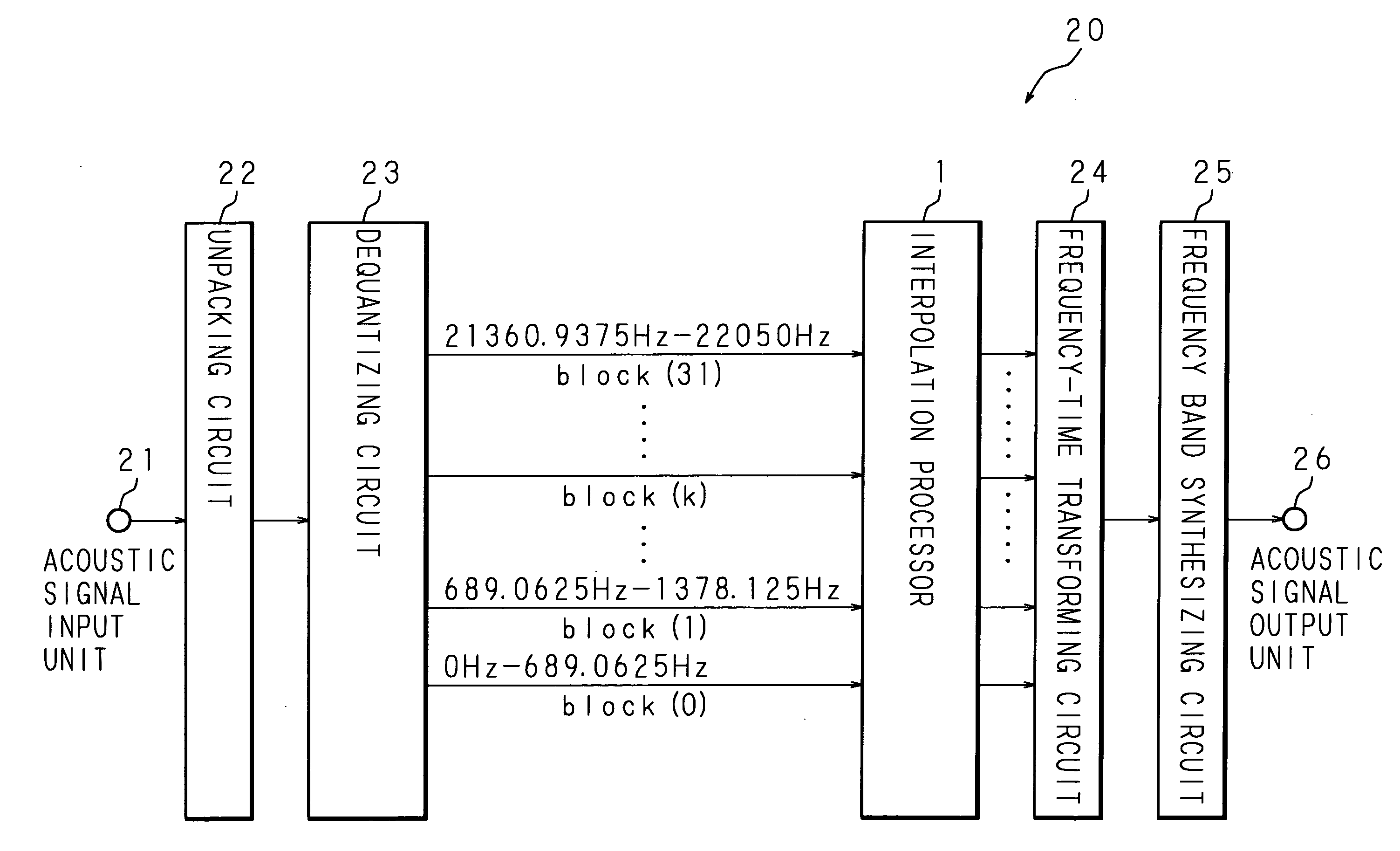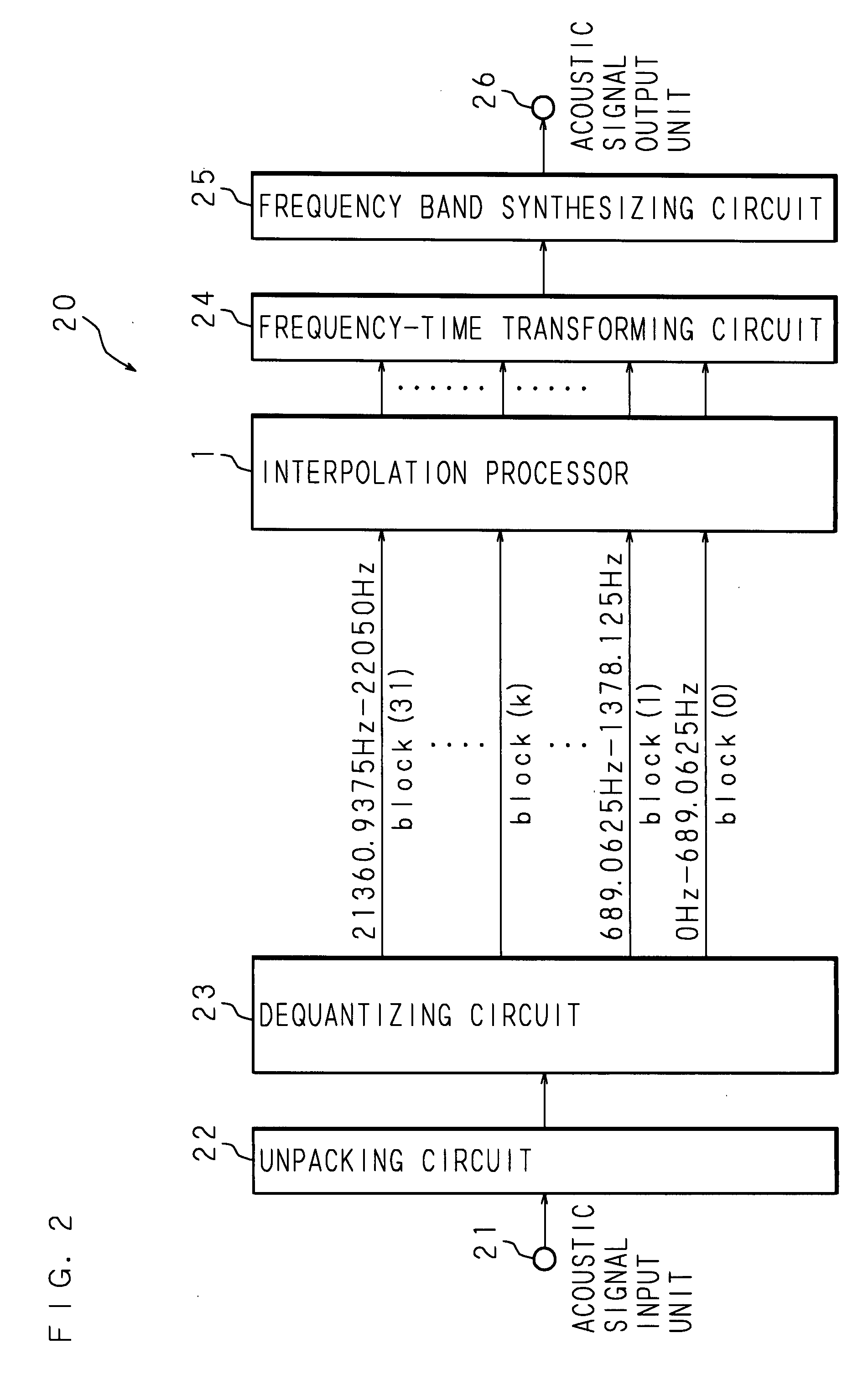Signal processing method, signal processing apparatus and recording medium
a signal processing and signal processing technology, applied in the direction of instruments, electrical transducers, transducer casings/cabinets/supports, etc., can solve the problems of energy loss of the acoustic signal, the inability to interpolate energy at all for the acoustic signal for which such power adjustment information is available, and the user may feel dissatisfaction at the acoustic signal, etc., to achieve enhanced quantized coefficient resolution, reprodu
- Summary
- Abstract
- Description
- Claims
- Application Information
AI Technical Summary
Benefits of technology
Problems solved by technology
Method used
Image
Examples
embodiment 1
[0086]The following description will explain an embodiment of the present invention with reference to the drawings. FIG. 2 is a block diagram showing the hardware structure of a decoding apparatus which is a signal processing apparatus. Denoted at 20 in the figure is a decoding apparatus for decoding a coded acoustic signal and comprises an acoustic signal input unit 21, an unpacking circuit 22, a dequantizing circuit 23, an interpolation processor 1, a frequency-time transforming circuit 24, a frequency band synthesizing circuit 25 and an acoustic signal output unit 26. It should be noted that, though the present embodiment is explained using an example wherein the MP3 is applied as a compression coding method, other methods may be applied similarly.
[0087]A coded acoustic signal read out from recording medium, a coded acoustic signal received by a digital tuner or the like is inputted into the acoustic signal input unit 21, and the inputted coded acoustic signal is outputted to the...
embodiment 2
[0125]Embodiment 2 relates to a form for correcting an interpolation coefficient. FIG. 7 is a block diagram showing the hardware structure of an interpolation processor 1 according to Embodiment 2. In addition to the structure of Embodiment 1, an effective range deciding circuit 15 and a correcting circuit 16 are added. A scale factor of each frequency band is extracted from frame side information of a bit stream outputted from the dequantizing circuit 23 and the extracted scale factor is inputted into the effective range deciding circuit 15. The quantization bit rate of a coefficient detected by the quantization bit rate detecting circuit 11 and the interpolation coefficient and the coefficient I(m) computed by the computing circuit 14 are inputted into the effective range deciding circuit 15.
[0126]FIG. 8 is a graph for explaining an effective range. In the graph of FIG. 8, a frequency is shown on the abscissa axis and the magnitude of a spectrum is shown on the ordinate axis. Each...
embodiment 3
[0142]FIG. 11 is a block diagram showing the structure of a signal processing apparatus 20 according to Embodiment 3. Each process of the decoding apparatus (signal processing apparatus) 20 according to Embodiment 1 may be realized by software executed by a personal computer. The following description will explain an example wherein the signal processing apparatus 20 is a personal computer 20. The personal computer 20 is a known computer comprising: a CPU (Central Processing Unit) 61; and a RAM (Random Access Memory) 62, a memory 65 such as a hard disk, an input unit 63, an output unit 64 such as a speaker and a communication unit 66, which can be connected with a communication network such as the Internet, that are connected with the CPU 61 via a bus 67.
[0143]A computer program for causing the personal computer 20 to operate can be provided in the form of a portable recording medium 1A such as a CD-ROM, an MO or a DVD-ROM as in the present Embodiment 3. Furthermore, it is also poss...
PUM
 Login to View More
Login to View More Abstract
Description
Claims
Application Information
 Login to View More
Login to View More - R&D
- Intellectual Property
- Life Sciences
- Materials
- Tech Scout
- Unparalleled Data Quality
- Higher Quality Content
- 60% Fewer Hallucinations
Browse by: Latest US Patents, China's latest patents, Technical Efficacy Thesaurus, Application Domain, Technology Topic, Popular Technical Reports.
© 2025 PatSnap. All rights reserved.Legal|Privacy policy|Modern Slavery Act Transparency Statement|Sitemap|About US| Contact US: help@patsnap.com



